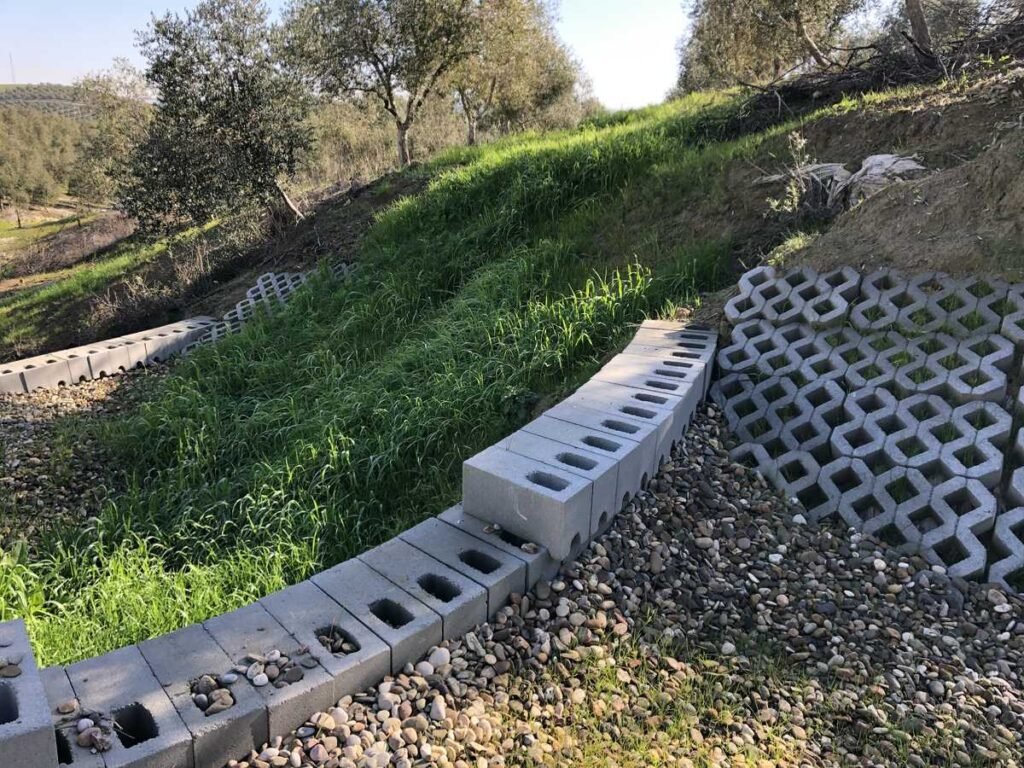This solution is the result of our participation in the INNOLIVAR project (read more).
A COMPREHENSIVE SOLUTION to control gullies
The solution has its starting point in the early detection of erosion processes and the evaluation of their intensity.
"Using aerial images, terrain information and rainfall types, we have developed a system that predicts which areas are most at risk of erosion and identifies the areas where problems are already most evident and action is urgently needed." (Tracasa)
Based on the information obtained, the solution provided proposes two specific actions, based on the combination of two INNOVATIVE TECHNIQUES that are easy to implement; the installation of dikes and the planting of vegetation covers.
METHODOLOGY AND IMPLEMENTATION
- INSTALLATION OF RETENTION DAMS AND FENCES that prevent the loss of fertile soil and improve the mobility of machinery on farms, greatly improving the methods used so far.
When the gullies are already very advanced in the terrain and make it difficult for machinery to pass through or for cultivation and/or harvesting work to be carried out, the construction of dikes is considered, together with the application of vegetation cover.
"We have designed different precast concrete pieces, which are assemblable thanks to their design. They have a weight of 25 kg, which enables installation without machinery and can be done by the farmer himself without using cement or concrete." (Prefhorvisa)
Two independent but related elements are considered: gully control and slope protection, through a combined use of blocks (dikes) and lattices (slopes and stilling basin).
The ease of the execution system allows the construction of the dikes by the farmer himself, following simple basic instructions. Based on a structure design with flexibility and adaptation to the land itself, appropriate for expansive clay soils.
Made from recycled aggregates, these pieces form dikes that are designed to reduce the erosive power of water flowing through them and stabilize the gully, and can be modified or removed in the future.
The design of the blocks is specific for this new use.
The ease of the execution system allows the construction of the dikes by the farmer himself, following simple basic instructions. Its size, shape and weight allow its execution without the need of machinery or auxiliary means.
They are wedge-shaped blocks that generate curvature in the dike, which gives the dike great stability, improving anchorage at the base and sides and the distribution of forces in the dike.
They are anchored to each other and do not require the use of mortars or auxiliary connectors. The design of the pieces facilitates the passage of water through the dike, reducing the erosive power of the water.
Recycled materials are used in production, with the possibility of manufacturing the pieces in an ochre color, thus achieving a lower environmental impact and greater integration into the landscape.
- Sowing of mixtures of wild species seeds of native origin, of high hardiness, in the gullies and their perimeter, created specifically for the creation of vegetation covers, which nourish and improve the soil, and adapted to the agro-climatic conditions of olive cultivation in Andalusia, with the aim of establishing a fine carpet on the ground to prevent erosion.
They are solutions based on Nature (SbN) that :
- Improve the degree of soil infiltration.
- They reduce runoff and water velocity.
- They cause sedimentation and the creation of fertile soil and life.
- Enables natural pest control.
They are complemented and improved with the sowing and planting of woody species inside the trellises and the slopes of the gully, to improve its stability and increase the degree of biodiversity inside the gully and to create refuge and reproduction spaces for birds and mammals of hunting interest in the olive grove.
A combined solution successfully tested in different olive farms in Andalusia.
"For this step we analyze which are the best MIXES for the creation of VEGETABLE COVERS WITH WILD PLANT SEEDS of AUTONOMOUS origin. specific to olive cultivation and for each soil, that are respectful of the environment and that do not compete with the crop itself. FOR THEIR CORRECT CHOICE we also take into account their future development, the phenological cycles, AS WELL AS THE EDAFOCLIMATIC CONDITIONS OF THE AREA OF ACTION".
These are compositions of plant seeds:
- Short-cycle annuals, with high self-seeding capacity, which guarantee the continuity of the vegetation cover over time.
- Fast and early germination.
- Rapid development and high propagation capacity, without competing with the crop.
- Manageable (narrow leaf). Easily controlled by mechanical or chemical methods.
- Low height. Medium/low growth habit.
- Good development of the root system, with good secondary root structure (dense and superficial) that can give consistency and support to the soil, without causing competition for the crop.
- Low vulnerability to pest infestation.
- Ability to mobilize nutrients from the soil.
- High fertilizer absorption capacity, thanks to the presence of leguminous plants that absorb all the excess nitrogen and purify runoff water.)
- With species not palatable for rabbits or other rodents.
Mixtures of native wild plant seeds, which also favor the attraction of birds and beneficial insects for the biological control of pests, ultimately helping to create life and improve the degree of biodiversity of the olive grove and its environment. A practice encouraged by the current European Agricultural Policy (CAP).
You can download the triptych on gully control by clicking on this link.
IMPORTANT NOTE:
This innovative solution is designed for use in agriculture, forestry, civil works or any other situation and location that requires correction of the terrain by means of a quick, simple and economical installation.









